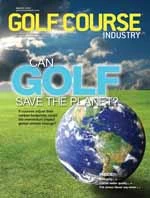During a recent visit to the Desert Mountain golf complex in Arizona, I had the opportunity to discuss the state of the industry with the eminent turfgrass scientist James B. Beard, PhD., president and chief scientist of the International Sports Turf Institute. His insights and evaluations of our sport’s affairs – both at home and abroad – should serve as a primer as the industry slowly emerges from its financial and agronomic woes.
Presently, Dr. Beard is focused on his second love (wife, Harriet, being the first!), which is writing books. He is the author of “Turfgrass Science and Culture” and “Turf Management for Golf Courses.” His newest project is a complete examination of turfgrass and soils history at the St. Andrews’ golf courses and their maintenance dating back to the 1800s. The Royal & Ancient Golf Club and St. Andrews’ library have opened up their archives, Green Committee transcripts, notes and letters, including photo documentation of practices and maintenance dating from 1840 to 1940.
- In comparing maintenance of yesteryear and current cultural practices, Dr. Beard points out several areas that have never changed and should remain a focus for the future:
- 50 percent of the game is contested and played within the putting green. Therefore, 50 percent of maintenance efforts should be placed there.
- Hole maintenance was always key, including proper selection, cutting, flag placement and debris removal from the area adjacent to the primary target. In the early days sweeping of rabbit pellets was practiced much earlier than grass cutting.
- In 1830 Edward Budding introduced the mower, but its use at St. Andrews’ Old Course did not occur until the late 1880s. Today, we are intent on a quality cut for turfgrass health and playing quality.
- Fertility was created from manure composted into organics. Similar to today, the odor was a concern. The use of the first artificial product – ammonium sulfate – occurred in the 1920s.
Traveling the world as a consultant and researcher, Dr. Beard has noticed our foreign brethren are focusing on quality maintenance and agronomics with an emphasis on gathering as much information as is available to enhance quality.
Good lessons for us to follow include:
- Be hungry for science-based information and proven research to produce a better quality product.
- While turfgrass perfection is a goal, it’s seldom achieved. When it is occasionally attained, it’s fleeting. The closer to perfection, the more obvious the imperfections appear.
- As an industry (on and off the golf course) we should accept a less-than-perfect lie. Most 20-handicap players could not handle a perfect lie anyhow. Why stress our turfgrass and ourselves trying?
- Consider the rising costs of maintenance, environmental pressures, governmental impacts and the need for conservation as a guide for your maintenance plan.
- Water is the next oil. Be wary of governmental interference or future city planning where water may not be available for golf courses.
- Turfgrass research must be ongoing and supported by all within the golf world. Fundamentals of turfgrass growth and basic maintenance should be the focus.
- The industry should not over-think issues. Instead, we should concentrate on the scientific process of realizing the problem, identifying the cause, researching the control and implementing cultural practices to minimize occurrences.
- Try to produce a healthy plant, relying less on pesticides. Environmental forces have and will restrain use of many products and as we lose these products, turfgrass quality eventually could suffer.
- Implement quality and properly-timed cultural practices to enhance healthy turfgrass and soils.
- Beyond turfgrass science, we all should be open to bringing more people into the game. Endorse programs that encourage growth of the game, especially those that encourage young people to pursue roles in the business of golf.
- There should be a focus on fun – whether playing the game or working within the industry.
- We should be careful not to make courses too hard and do our best to make golfers come back again because they enjoyed their day.
- Be cautious of the rising costs that make the game unaffordable and too elitist.
In closing Dr. Beard expressed his gratitude for all he has received from golf, including a remarkable set of friends and associates around the world.
We should offer him a huge thank you, as well. GCI

Explore the March 2010 Issue
Check out more from this issue and find your next story to read.
Latest from Golf Course Industry
- Golf Construction Conversations: Reed Anderson
- ’Twas the Night Before Christmas (on turf)
- Twas the Night Before Christmas (the turf version audio)
- Advanced Turf Solutions and The Aquatrols Company release soil surfactant
- Heritage Golf Group acquires North Carolina courses
- Editor’s notebook: Green Start Academy 2024
- USGA focuses on inclusion, sustainability in 2024
- Greens with Envy 65: Carolina on our mind





